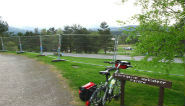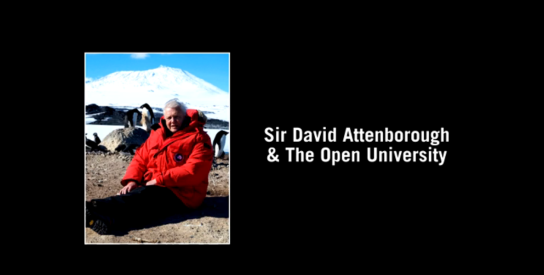 For many, the varied landscapes found at the coast are a defining feature of the British Isles. Yet there is increasing concern about the future of coastal landscapes and environments, as scientists, planners and public come to terms with the implications of future environmental change driven by changing climate. Sea levels around the UK are currently rising at around 3mm per year, and a projected increase in the number and intensity of storms and other extreme weather events attributed to human-induced climate change is likely to intensify the processes of coastal change. Beaches and soft cliff faces are easily eroded by storm waves and surging tides; farmland and precious habitats, homes and property are lost to the sea.
For many, the varied landscapes found at the coast are a defining feature of the British Isles. Yet there is increasing concern about the future of coastal landscapes and environments, as scientists, planners and public come to terms with the implications of future environmental change driven by changing climate. Sea levels around the UK are currently rising at around 3mm per year, and a projected increase in the number and intensity of storms and other extreme weather events attributed to human-induced climate change is likely to intensify the processes of coastal change. Beaches and soft cliff faces are easily eroded by storm waves and surging tides; farmland and precious habitats, homes and property are lost to the sea.
Sound is one of the most powerful ways in which places are experienced through the senses. Whereas eyes can be closed and vision can be focused in a particular direction, ears remain open to sounds generated from all around, and humans are more 'vulnerable' to sounds as a result. Particular sounds can evoke powerful memories of people and places too. In the past, geographers were mostly concerned with what places and environments looked like in maps and pictures. More recently, though, some geographers have turned their attention to senses such as smell, touch and sound, in order to gain a better understanding of different ways in which people experience place.
Sounds experienced on and by the sea can tell geographers a lot about how people experience and value coastal landscapes, particularly when these are under threat from rising sea levels. Asking people to choose sounds that remind them of a favourite beach or cove can help people express thoughts and feelings they might otherwise find difficult to put into words.
Sounding our shores
The National Trust is a charity in England and Wales dedicated to the protection of built and landscape heritage. The National Trust now has in its care over 775 miles of British coastline including iconic landscapes such as the white chalk cliffs of Sussex at Beachy Head, heathlands at Lizard Point, the southernmost part of England, the spectacular cliffs of Pembrokeshire in Wales and the coastal marshes of North Norfolk. In 2014 it launched the Sounding Our Shores project, which was designed to draw attention to the importance that is attached to the coast in Britain and to raise awareness of the changes and threats that valued coastal landscapes face in the future. As part of that project, the National Trust asked people to record and upload their favourite seaside sounds to a website. The website has a map of the UK coastline, and you can click on the map to hear the recordings sent in.
Activity
Listen to the following sounds which were generated as part of the Sounding Our Shores project. They evoke a range of seaside locations and experiences which may be familiar to many. Do any of these sounds remind you of a particular memory, a time and place beside the sea?
Tide coming in just west of Portmeirion
Children and dogs play on Bream Cove
Waves from the cliffs, Beagle's Point
Sound of seagull flying over Harwich beach, Essex
The composer and sound recordist R. Murray Schafer developed a way of categorising sounds and you may recognise some of the sounds presented here as what he called ‘Keynote Sounds’, which exist in the background and are not normally noticed because they are so familiar, like the wind and the hum of traffic. Others are ‘Sound Signals’, designed to attract attention and provide a warning’ like a coastal foghorn. However, because these sounds have been singled out, recorded and uploaded by members of the public, all these sounds are also what Schafer termed ‘Sound Marks’.
These are sounds which in some way have a special association with a particular place and might be highly valued by either or both local residents and visitors. As well as these kinds of sounds, musicians also create work to evoke the sea. The musician and music producer Martyn Ware composed a soundwork called The British Coastline from the sound recordings uploaded by the public to the Sounding Our Shores website.
In interviews, Martyn argues that soundwork emphasises the power of sound to evoke memories and to affect humans deeply and directly about places, landscapes and environments. Perhaps sound is really a neglected means of communication for those who want to communicate about environmental issues. What we can learn from these various examples of different kind of sounds, then, is that all sorts of sounds can powerfully convey the effects of environmental change on vulnerable landscapes like beaches.
Further reading and references
The audios in this article were recorded by audioBoom, as part of the British Library and National Trust’s Sounds of our Shores project.
The Open University module DD103 studies soundscapes in week 23.
Study a free course on the environment
-
Environment: treading lightly on the Earth
Learn more to access more details of Environment: treading lightly on the EarthEnvironment: treading lightly on the Earth focuses on the problem of greenhouse gas emissions, especially carbon dioxide. This free course will give you an understanding of the nature and importance of carbon footprints of individuals and households. It will enable you to measure your own carbon footprint and explore what you could do to reduce ...

Free course
15 hours
Level: 1 Introductory
-
Eating for the environment
Learn more to access more details of Eating for the environmentThis free course, Eating for the environment, will explore the links between food, nutrition and environmental sustainability.

Free course
8 hours
Level: 2 Intermediate
-
Could we control our climate?
Learn more to access more details of Could we control our climate?Climate crisis is one of the grand challenges we face as a society, but it can be hard to approach as a subject. Not only can the science at times seem dauntingly complex, but the solutions are also far from clear. This leaves many people feeling confused, guilty, anxious, angry, or else completely switched off from the subject. This course ...

Free course
24 hours
Level: 1 Introductory
-
Introducing environmental decision making
Learn more to access more details of Introducing environmental decision makingMany of the decisions we make have implications for our environment, particularly those concerning natural resources and waste. Taking account of environmental factors in decision making can be both complex and challenging. This free course, Introducing environmental decision making, considers decisions in their broader contexts and advocates a ...

Free course
24 hours
Level: 3 Advanced
-
Introducing the environment: Ecology and ecosystems
Learn more to access more details of Introducing the environment: Ecology and ecosystemsWhat is ecology and why is it important to our understanding of the world around us? This free course, Introducing the environment: Ecology and ecosystems, looks at how we can study ecosystems to explore the effect that humans are having on the environment.

Free course
5 hours
Level: 1 Introductory
-
Environmental management and organisations
Learn more to access more details of Environmental management and organisationsIt is believed that environmental management requires action at all levels and by organisations of all types and sizes. However it is not always clear what we mean by environmental management and the role that organisations do and could play. This free course, explores the different interpretations and viewpoints involved by using system ...

Free course
15 hours
Level: 2 Intermediate
Read more articles like this
-
Weather derivatives - the financialization of weather
Listen now to access more details of Weather derivatives - the financialization of weatherIs it possible to manage the risks presented by nature, such as too much rain at the wrong time of the year and very harsh frosts?

-
The European Union and the impact on mixed nationality relationships in northern Finland
Listen now to access more details of The European Union and the impact on mixed nationality relationships in northern FinlandCarol Brown-Leonardi investigates how Britain’s exit from the European Union has affected the perceptions and decision-making of mixed nationality couples to stay and live permanently in Finland or the United Kingdom.

-
Investigating environmental futures through speculative design
Read now to access more details of Investigating environmental futures through speculative designHow can ‘thinking through making’ facilitate new kinds of geographical enquiry?

-
Climate Change, Coastal Erosion and Flooding: The Thames Gateway and London
Read now to access more details of Climate Change, Coastal Erosion and Flooding: The Thames Gateway and LondonClimate change will lead to sea level rises and this will lead to enhanced coastal erosion. Professor David Humphreys explores the challenges that this will pose for the Thames Gateway in south-east England.

-
Convoy to Calais
Watch now to access more details of Convoy to CalaisHow should we respond to humanitarian crises in other countries? Steve Pile explores the geographies that underlay the 2016 “Convoy to Calais” protest.

-
Kropotkin, anarchism and geography: A discussion
Listen now to access more details of Kropotkin, anarchism and geography: A discussionWhat links geography to anarchism? Dr Philip O’Sullivan finds the surprising connection lies with a Russian prince who died nearly 100 years ago.

-
The sharing economy
Take part now to access more details of The sharing economyHow sharing and caring is the sharing economy? Petr Jehlička takes a critical look at the booming sector and traces its hidden connections and contradictions.

-
From Brexit to the break-up of Britain?
Learn more to access more details of From Brexit to the break-up of Britain?This free course, From Brexit to the break-up of Britain?, sets the experience of Brexit in the context of the UK. It first analyses Brexit as a symptom of the political, economic and social geography of the UK, focusing on its uneven development in a country increasingly dominated by London and the South East of England. It then considers how ...

-
Climate change's causes, effects and geographies of responsibility
Read now to access more details of Climate change's causes, effects and geographies of responsibilityThe idea of climate change is increasingly well-known, but it can be hard to understand its effects in human terms. Professor David Humphreys describes how he experienced Climate Change first hand when working in Bangladesh for The Open University.

-
International health service: How the NHS has always relied on overseas labour
Read now to access more details of International health service: How the NHS has always relied on overseas labourPotential NHS staff from outside of European Economic Area (EEA) will shortly find it easier to secure permission to work in the UK. Yet doctors and nurses from the EEA may no longer have the right to do so. Dr Parvati Raghuram looks at how the NHS has depended on foreign workers since its creation.

-
Can we live harmoniously with wildlife?
Read now to access more details of Can we live harmoniously with wildlife?In light of a man-eating tiger being killed in The Nilgiris District, India, we need to address human-animal and human-human conflict in our forests.

-
The navigation apps that help the visually impaired
Read now to access more details of The navigation apps that help the visually impairedA technological revolution is underway improving the lives of many who may benefit from additional assistance says human geographer, Dr Oliver Zanetti.

-
How do you know you are in a smart city?
Watch now to access more details of How do you know you are in a smart city?Integrated urban technology is less apparent when it is functioning well says, Gillian Rose, Professor of Human Geography at the University of Oxford.

-
Studying Environments and Societies
Listen now to access more details of Studying Environments and SocietiesWhat does human geography have to do with studying the environment?

-
How data is making our cities smarter
Watch now to access more details of How data is making our cities smarterData research may lead to more efficient, sustainable and democratic societies says Gillian Rose, Professor of Human Geography at the University of Oxford.

-
Approaching the break up of Britain?
Read now to access more details of Approaching the break up of Britain?What does the geography of the referendum vote tell us about the (increasingly dis-) United Kingdom?

-
Five smart technologies helping the visually impaired
Watch now to access more details of Five smart technologies helping the visually impairedCutting-edge research is enabling the development of new potentially life-changing prototypes aimed at serving those with disabilities says, Dr Oliver Zanetti.

-
Can yoga help us achieve sustainable development goals?
Read now to access more details of Can yoga help us achieve sustainable development goals?Shonil Bhagwat explains the yogic way of understanding how individual actions relate to global challenges.

-
Gender, IT and economic growth
Read now to access more details of Gender, IT and economic growthDoes gender matter to the world's fastest growing economies? Parvati Raghuram explores how the labour driving many Rising Powers is gendered.

-
My Interest in Cities is Really an Interest in the Way People Live
Watch now to access more details of My Interest in Cities is Really an Interest in the Way People LiveHow do cities bring places, relationships and networks together, and what sorts of politics do they create?

-
Non-existent countries
Listen now to access more details of Non-existent countriesWhat makes a country count as a country? Andy Morris interviews geographer and broadcaster Nick Middleton about his recent book 'An Atlas of Countries that Don't Exist'.

-
United Nations Climate Change Conference - COP21
Take part now to access more details of United Nations Climate Change Conference - COP21This interactive map is a world first. It gives you the chance to explore a major international meeting on climate change as if you were there.

-
Earth In Vision: A Collection
Watch now to access more details of Earth In Vision: A CollectionThe Earth in Vision project explores the BBC archives of environment themed television and radio programmes from the last 70 years, looking at the potential of these archives as a digital resource as well as to illustrate the potential of digital broadcast archives for researchers.

-
Stories of Change - The Interviews
Listen now to access more details of Stories of Change - The Interviews'Stories of Change' interviews with Roger Harrabin.

-
Dropping the population bomb - 50 years of BBC environmental broadcasting, part two
Read now to access more details of Dropping the population bomb - 50 years of BBC environmental broadcasting, part twoHow have the films and radio programmes broadcast by the BBC shaped how we understand environmental change issues? Joe Smith shares his journey through the archives in the second part of a two part podcast series.

-
Fifty years of BBC broadcasting about environmental change issues
Listen now to access more details of Fifty years of BBC broadcasting about environmental change issuesHow have the films and radio programmes broadcast by the BBC shaped how we understand environmental change issues? Joe Smith shares his journey through the archives in a two part podcast series.

-
Syria, Spitsbergen and Seeds
Listen now to access more details of Syria, Spitsbergen and SeedsHow are the civil war in Syria, the remote Norwegian island of Spitsbergen, and the future of the world’s food supplies connected?

-
The Legacy of Nuclear Power, Part 2
Listen now to access more details of The Legacy of Nuclear Power, Part 2What ethical decisions does burying nuclear waste involve, and how are we responsible to future generations?

-
Another spoonful? Understanding the Place of Sugar - Part Two
Read now to access more details of Another spoonful? Understanding the Place of Sugar - Part TwoSteve Pile looks at the changing geographies of sugar.

-
One Lump or Two? Understanding the Place of Sugar - Part One
Read now to access more details of One Lump or Two? Understanding the Place of Sugar - Part OneSugar is a Contradiction - explore the cultural paradox of this ubiquitous ingredient, with Professor Steve Pile.

-
Protecting Landscapes and Creating the Right Tools for the Job
Listen now to access more details of Protecting Landscapes and Creating the Right Tools for the JobHow do national parks manage the demands of different users, whilst still conserving natural beauty?

-
The Legacy of Nuclear Power: Part 1
Listen now to access more details of The Legacy of Nuclear Power: Part 1How do local communities respond to the risks and opportunities of nuclear power?

-
Researching cycling in the US & the UK
Listen now to access more details of Researching cycling in the US & the UKPeter Wood shares his experiences researching cyclists - on both sides of the Atlantic.

-
Why I believe 'yes' is only a matter of time
Listen now to access more details of Why I believe 'yes' is only a matter of timeDespite voters in 2014 choosing to stay in the United Kingdom, Gerry Mooney believes that in the long run, an Independent Scotland is inevitable. He explains why.

-
Family photos and what they mean
Watch now to access more details of Family photos and what they meanWhat can family photos tell us about households, gender roles and emerging technology? Professor Gillian Rose explores her research on family photography, and how this work interacts with her own experiences.

-
Coping on the Coast: moral economies and liminality at the heart of things that matter
Watch now to access more details of Coping on the Coast: moral economies and liminality at the heart of things that matterDoes geography influence peoples’ sense of security and well-being?

-
‘Citizen sensing’ and new forms of environmental monitoring
Read now to access more details of ‘Citizen sensing’ and new forms of environmental monitoringWhat technological challenges are faced by communities seeking to understand environmental change at different geographical scales?

-
Should we be worried about the US withdrawal from the Paris climate agreement?
Read now to access more details of Should we be worried about the US withdrawal from the Paris climate agreement?The UK government has confirmed that despite the path chosen by the US, the UK would honour the Paris Agreement. Here Shonil Bhagwat looks at the motivations and implications behind the US decision, and how international action on climate change will go on.

-
Should Economics and the Environment work together?
Listen now to access more details of Should Economics and the Environment work together?The recent UK general election saw many parties pledge to ‘improve’ the environment. Vicky Johnson considers progress can be measured by more closely connecting the environment to economics.

-
How is Milton Keynes a ‘smart’ city?
Watch now to access more details of How is Milton Keynes a ‘smart’ city?What is a ‘smart city’, and how is smart rooted into Milton Keynes’ past and future?

-
Milton Keynes and the roots of 'Smart' transport
Watch now to access more details of Milton Keynes and the roots of 'Smart' transportLearn about MK’s unique history of transport innovation, and how The Open University has been a part of the experiment.

-
Smart Cities in the Making: Learning from Milton Keynes
Watch now to access more details of Smart Cities in the Making: Learning from Milton KeynesWhy research Milton Keynes? Professor Gillian Rose introduces a study of how cities are increasingly using digital data to improve their management and create new ways of living.

-
Sir David Attenborough and The Open University
Watch now to access more details of Sir David Attenborough and The Open UniversitySir David Attenborough and The Open University have had a long-standing relationship since the university's birth. David explains how that relationship came about and how it has developed over the years.

-
The Curious Geography of Weetabix: A Cereal Tale for Our Times
Read now to access more details of The Curious Geography of Weetabix: A Cereal Tale for Our TimesWhere is Weetabix actually from? Prof. John Allen investigates.

-
This is not a city: Milton Keynes
Read now to access more details of This is not a city: Milton KeynesWhat makes a city and why does it matter?

-
Europe’s Borders in Question
Read now to access more details of Europe’s Borders in QuestionStories about migrants, asylum seekers and refugees make media headlines almost every day. John Allen asks, what's the role of borders in this movement of people?

-
Introducing Geography Matters
Read now to access more details of Introducing Geography MattersThe 'Geography Matters' initative is coming to the Faculty of Arts and Social Sciences.

-
Brexit and the Irish border
Read now to access more details of Brexit and the Irish borderHow are Brexit and the Irish border connected? Dr Philp O'Sullivan reflects on the changing geographical relationship between the UK and Ireland.

-
Privatising Thames Water
Read now to access more details of Privatising Thames WaterHow did a public utlity turn into a financial instrument?

-
Seeing the internet
Read now to access more details of Seeing the internetHow do we see the internet? Gillian Rose explores why some artists and campaigners think it's important that the internet is made more visible.

-
Climate change: the kale smoothie of TV
Read now to access more details of Climate change: the kale smoothie of TVIs climate change the kale smoothie of TV schedules: unappealing but somehow fashionable and even essential to the diet?

-
The environmental costs of Trump’s wall
Read now to access more details of The environmental costs of Trump’s wallTrump's wall will not only have long-lasting impact on human society, but also severe ecological consequences.

-
Heathrow third runway: who and where will benefit?
Read now to access more details of Heathrow third runway: who and where will benefit?Exploring the costs and benefits of expanding Heathrow, using a geographical analysis.

-
Change in the West of Ireland
Read now to access more details of Change in the West of IrelandIntroducing a collection of articles asking 'How can unique and distinctive regions, like the West of Ireland, retain the qualities that make them unique while continuing to modernise and interact with the wider world?'

-
Scoring the Shoreline
Read now to access more details of Scoring the ShorelineGeorge Revill considers the synergy between sound waves and ocean waves - how the coast of Britain has inspired the nation's musical heritage.

-
London inside out
Read now to access more details of London inside outFifteen years since the 7/7 bombings, we look back at unity in London after the terror attacks...

-
Methods in Motion: Getting on your bike, and looking for answers
Read now to access more details of Methods in Motion: Getting on your bike, and looking for answersDr Peter Wood, a Visiting Fellow with the Geography Discipline, argues that although methodological choices are often seen as technical decisions, they can actually be key to intellectual creativity.

-
Is public spending a drain on the economy or the mark of a civilised society?
Read now to access more details of Is public spending a drain on the economy or the mark of a civilised society?Read this article outlining arguements in debate held under the auspices of the Social Sciences Student Connections, Big Conversation.

Rate and Review
Rate this audio
Review this audio
Log into OpenLearn to leave reviews and join in the conversation.
Audio reviews